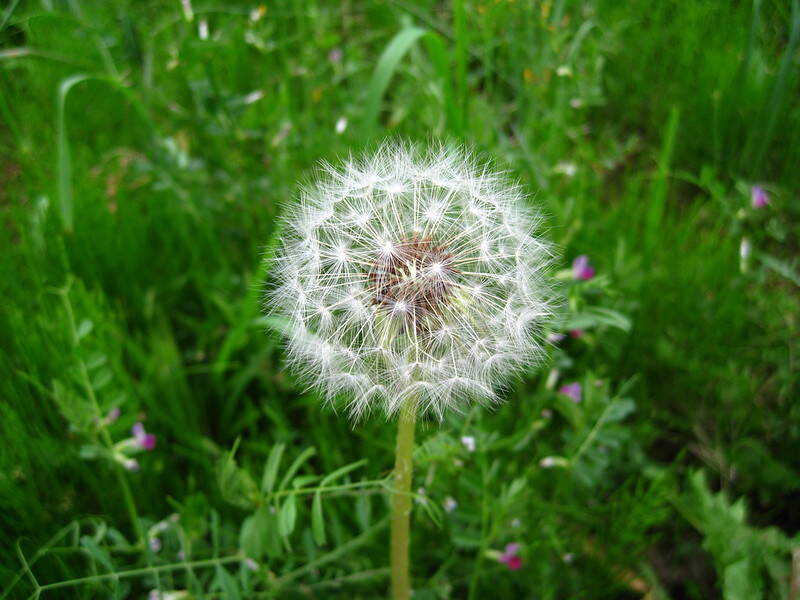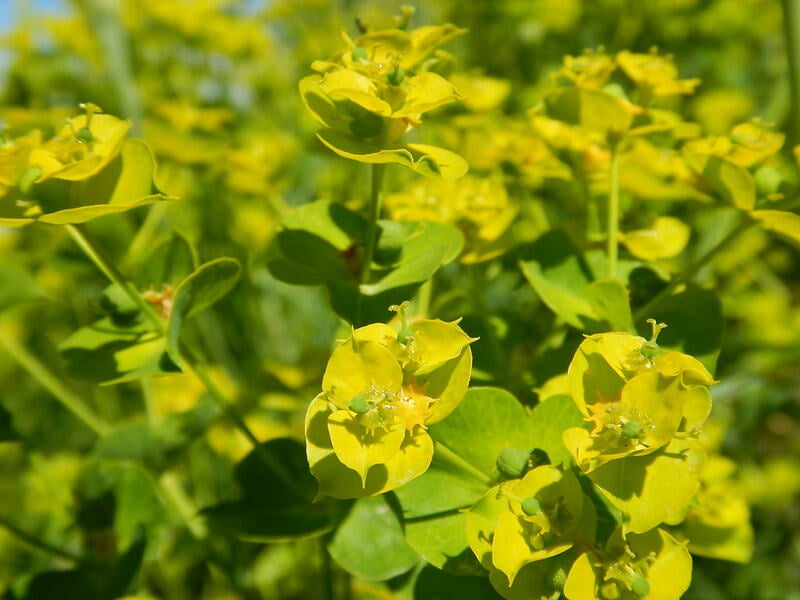
Indiana, the land of cornfields, basketball, and… weeds? Yes, from wild violet to white clover and crabgrass and chickweed, discover the most common weeds in Indiana lawns.
A battalion of unwelcome weeds is vying for a spot in your yard. They are invasive grasses, flowering plants, and vines. Some are beautiful and others dangerous, so correctly identifying them is crucial to protect your lawn.
1. Canada Thistle

Canada thistle can produce allelochemicals that stunt the growth of nearby plants, making sure it’s the star of your yard, whether you like it or not.
- Appearance: Its leaves are shallow-lobed and toothed, with spiny margins. The upper surface of the leaves is dark green and smooth, while the underside is light green and covered with woolly hairs. Reaching up to 3 feet tall, this weed can quickly become a towering nuisance on your lawn.
- Germination: From June through August, Canada thistle displays its purplish-pink flowers. These blooms produce numerous seeds equipped with “parachutes,” allowing them to ride the wind and spread far and wide. Additionally, this weed has a robust underground root system that helps it to regenerate and pop up in new spots.
2. Common Chickweed

Common chickweed is a winter annual broadleaf weed that likes shady, moist areas. It’s even bold enough to grow in mulch, making it a persistent nuisance for gardeners.
- Appearance: Common chickweed forms a low, rounded mound of leaves. Its prostrate stems sometimes root at the nodes. The roots are fibrous. The leaves are opposite, very small, and smooth, with a pointed tip and teeth on the edges. The flowers are small, featuring five deeply divided petals that appear as 10.
- Germination: Common chickweed germinates from seed in late summer or early fall. Once established, it thrives in the cooler months, taking advantage of the shady, moist areas in your lawn and garden beds.
3. Crabgrass

Crabgrass loves to invade Indiana lawns. It is an aggressive warm-season annual that loves to outcompete cool-season turfgrasses when the summer sun turns up the heat and rain becomes scarce.
- Appearance: Its leaves are broader than the average grass blades, growing in clumps close to the ground and resembling a crab’s legs, hence the name. You can notice its light yellow color, but as it matures, its leaves take on a dark red shade.
- Germination: Crabgrass is a master at survival and proliferation. It germinates in the spring. It can produce thousands of seeds in a single season during the hot Indiana summer.
For control tips, see our article: “How to Get Rid of Crabgrass in Your Yard.”
4. Dandelions

Dandelions can pop up anywhere, turning your well-manicured lawn into a mess.
- Appearance: Dandelions are short-lived perennials with deep and thick taproots that extend up to 3 feet long, making them tough to eradicate. Their jagged-edged leaves and hollow, leafless stems end in a bright yellow flower head. This flower will later turn into a fluffy white head. If you cut any part of this plant, it oozes a milky white juice.
- Germination: Dandelions bloom from March to November. Its yellow flowers transform into white seed heads, each capable of holding up to 20,000 viable seeds.
Check out this article for control tips: “How to Get Rid of Dandelions.”
5. Ground Ivy

Ground ivy is a perennial broadleaf weed that invades Indiana lawns and landscapes. It prefers moist, fertile, and shady spots but is tough enough to tolerate full sun as well.
- Appearance: Ground ivy is easy to recognize because of its leaves which are kidney-shaped, about an inch wide, and have scalloped edges. They grow opposite each other on long petioles and almost encircle the petiole. When crushed, the leaves emit a minty scent.
- Germination: Ground ivy produces small purple flowers in May, but they are often overlooked. This weed forms long, slender stolons that root at the nodes, making it an aggressive spreader. Its ability to root at multiple points makes it particularly difficult to control.
6. Leafy Spurge

Leafy spurge is a toxic perennial weed. Despite its attractive appearance, this weed is anything but friendly.
- Appearance: Leafy spurge grows in clusters with upright stems that reach 3 to 4 feet tall. It has showy, yellowish-green, heart-shaped bracts that enclose small flower clusters. If you break a stem of the plant, it releases a toxic, milky sap that can cause blisters on your skin and even permanent blindness if it gets in your eyes.
- Germination: Leafy spurge blooms from late spring to mid-summer. Each flower produces an average of 140 seeds, making it a prolific spreader. It has deep taproots and extensive lateral roots, making it a tough competitor for your lawn’s resources.
7. Nutsedge

Nutsedge, also known as nutgrass, is a fast-growing perennial that loves to invade Indiana lawns. Despite its name, it’s not actually grass, it’s an aggressive weed that can outcompete your turf, especially during the hot summer months.
- Appearance: Nutsedge stands out from your typical grass blades because it tends to grow a bit taller and has a pale green color. Its strands grow faster than most grasses. You can identify nutsedge by its stems, which grow in a distinctive “V” shape.
- Germination: Nutsedge appears in the spring and continues to grow actively until the first frost in autumn. It produces flowers and seeds in clusters of short spikes. This weed can form underground structures called nutlets. These small, round nutlets can lie dormant for 10 years, waiting for favorable conditions to sprout.
To get rid of this weed, check out our article: “How to Control Nutsedge in Your Yard.”
8. Poison Ivy

Poison ivy is a perennial poisonous broadleaf weed that can turn any Indiana lawn into a risky venture. Whether in the sun or shade, this troublesome plant is a master of disguise and irritation.
- Appearance: Poison ivy can grow as a woody shrub or a vine. Its leaves are alternate, each featuring three large leaflets. The edges of these leaflets may or may not be toothed, and their shape can vary widely. Contact with poison ivy can cause a rash and intense itching because of the oil resin present on the plant.
- Germination: Poison ivy becomes more noticeable during the spring and summer months. It produces greenish-yellow flowers in clusters at the leaf axils. This weed spreads by seeds, creeping roots, and stems that root wherever they touch the ground. Birds often eat the seeds, contributing to its widespread distribution.
Note: Poison ivy leaves can be confused with maple tree seedlings because of their similar-looking leaves.
Check out this article for control tips: “How to Get Rid of Poison Ivy.”
9. Quackgrass

Quackgrass is the resilient lawn invader that keeps Indiana gardeners on their toes. This aggressive cool-season perennial isn’t picky about its environment. It can grow in everything from partly shaded nooks to full sun.
- Appearance: Quackgrass grows unbranched and upright, reaching 4 feet tall. Its ashy blue-green leaves roll in the bud. A pair of narrow auricles clasp the stem at the base of each leaf blade.
- Germination: It germinates in the spring and sets seed in late summer. While it can reproduce by seed, many of those seeds are sterile. The real menace lies in its underground network of rhizomes, which spread fast.
10. White Clover

White clover is a persistent weed that shows up unannounced in Indiana lawns.
- Appearance: White clover is easy to spot for its white flowers. Each stem features clusters of more than five blossoms, and its three rounded leaflets give it a characteristic look.
- Germination: White clover germinates from April to December. Its aggressive stems and shallow roots enable it to spread above and below the ground.
Protect your lawn with this guide: “How to Get Rid of Clover and Not Kill Grass.”
11. Wild Violet

Wild violet is a perennial broadleaf weed that loves Indiana’s moist, shady, and fertile sites. While its delicate flowers might seem appealing, this weed can invade your yard.
- Appearance: Wild violet forms a rounded clump about 5 inches high. Its heart-shaped, waxy leaves have a long petiole, with the blade often cupping toward it. The flowers are a lovely sight with five petals that range in color from blue to violet.
- Germination: Wild violet flowers germinate in the spring. However, once the temperatures rise in summer, the flowers fade. This weed forms rhizomes that allow it to spread and establish itself on your lawn..
FAQ About Weeds in Your Indiana Lawn
How can I get rid of weeds on my Indiana lawn?
The first approach to get rid of weeds is by hand-pulling, but this is only suitable for small infestations. For larger infestations, use herbicides. Broad-spectrum herbicides are made for various weeds and selective ones for specific types. For more tips, see our article: “How to Get Rid of Stubborn Weeds in Your Grass.”
Do herbicides kill grass?
Non-selective herbicides will kill everything they touch: weeds, grass, flowers, and plants. In contrast, selective herbicides are formulated to target specific weeds without harming your grass.
Take a look at the following articles about herbicides:
- Types of Post-Emergent Herbicides
- 8 Best Post-Emergent Herbicides [Reviews]
- Applying Post-Emergent Herbicides to Your Lawn
What is a pre-emergent herbicide?
A pre-emergent herbicide is applied to lawns before weeds germinate. Its function is to prevent weed seeds from sprouting and growing, stopping them before they become visible.
Here are some useful information about pre-emergent herbicides:
- 8 Best Pre-Emergent Herbicides for Lawns [Reviews]
- When and How to Use Pre-Emergent Herbicides to Kill Your Lawn’s Weeds
When to Hire a Professional
If after identifying these common weeds in Indiana you’re finding it tough to keep them at bay and maintain a beautiful lawn, contact a lawn care professional. They have the expertise to effectively manage and control weeds, ensuring your yard remains healthy year-round.
More Lawn Care and Landscaping Resources for Indiana:
- When to Aerate Your Indiana Lawn
- The Best Time to Plant Grass Seed in Indiana
- When to Overseed Your Indiana Lawn
- The Best Grass Seed for Indiana Lawns
- When to Fertilize Your Indiana Lawn
Main Photo Credit: Dandelions. Sergey Fedoskin / Adobe Stock Free / License